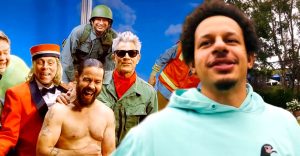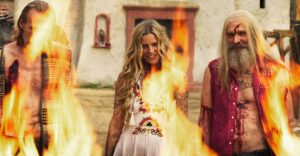Hillbilly Elegy True Story: What The Movie Changes About J.D. Vance’s Family

Part of every writer’s job when adapting stories to the big screen is to make changes that would make for a better movie, and Ron Howard’s 2020 adaptation of J.D. Vance’s memoir Hillbilly Elegy is no exception to those sorts of changes. While the vibrant Appalachian characters that comprise J.D.’s family maintain their essence in many ways, Howard and company re-ordered and embellished certain plot points to affix a more appropriately cinematic structure to the story. Although these changes certainly failed to rescue Hillbilly Elegy from dismal reviews, it’s worth examining what’s real and what is, as Mank would say, the “magic of the movies.”
The word “Hillbilly,” claimed by Vance as a term of endearment in describing the characters of his rural upbringing, certainly applies to the film’s principal cast. Glenn Close plays J.D.’s grandmother, “Mamaw,” who, after getting pregnant at the tender age of 13, weathered an abusive marriage and cyclical poverty. Despite her best efforts to the contrary, she passed these onto J.D.’s mother Bev, portrayed by Amy Adams, who herself struggles with poverty and a revolving door of boyfriends/husbands after giving birth to her first child Lindsay (Haley Bennett) at 19 and later J.D. (Gabriel Basso). The two siblings spend much of their adult timeline in the film reckoning with their mother’s relapse, as flashbacks show Bev’s persistent drug addiction. Each of the Hillbilly Elegy’s characters remains true to their nature in most respects, but certain elements and plot points differ between the real story and the film.
J.D. Vance

As the primary subject and point of view for the memoir, it’s natural that most of the changes principally affect J.D. Yes, he grew up in Middletown, OH, after his Mamaw and Papaw moved there from Kentucky seeking a better life for their family, and yes he encountered various instances of elitist prejudice at Yale, including the silverware confusion and dismissive comments about state schools represented in the film. His girlfriend, Usha, is very much real, having clerked for then-Judge Kavanaugh – yes, the same Kavanaugh of SCOTUS confirmation meltdown fame – and she did help him acclimate to the upper-class dogma.
It’s in the present-timeline of the film where most of the differences come in. While Vance writes about his mother’s many relapses in his memoir, nowhere is there mention of him returning home hours ahead of a final interview to put Bev in a rehab facility. And the four credit cards he uses to front the cost for that stay? Also missing from the true story. The conflict between J.D.’s fear of his tumultuous past and Usha’s offers of help is also played up to increase dramatic tension. These elements serve to position Vance’s character between Mamaw’s insistence that family is “the only thing worth a goddamn” and his dreams of escaping the cycle of poverty. Although Hillbilly Elegy drew heavy criticism for its “pick-yourself-up-by-your-bootstraps” ethos, the dramatization helps to clarify this conflict suggested by the source material.
Bev Vance

A character seemingly drowning in suffering of her own design, it bears questioning the reality of Bev’s portrayal in the film. In fact, the film gets more right than one might think while watching what has been described as “poverty porn.” J.D. saw her get arrested multiple times in his youth, and the movie selects one of those instances to dramatize in a sequence where he runs into a nearby house seeking shelter from a violent Bev (although Vance’s snap-acquittal of his mother is of questionable veracity). Bev did take a roller-skating trip through the hospital where she worked as a nurse, and it did get her fired. Her slew of boyfriends and her marriage to her boss at the dialysis center is accurate, and J.D.’s subsequent delinquency is fairly faithful.
Where the film wanders astray from the true story comes mostly in the form of drug problems. While Bev certainly did struggle with addiction, and the request for clean urine and her relapses are familiar to readers of the memoir, Adams’ performance implies a deeper mental illness not stated in the text. Her turn-on-a-dime mood swings, which Vance attributes to the drugs, suggest a character who was unwell far before falling prey to heroin or the like. This decision reinforces the spirit of the character, but it doesn’t necessarily ring true to the author’s work.
Bonnie Blanton (“Mamaw”)

This veteran actress’ performance is one of the few critical bight spots of Hillbilly Elegy, both endearing and empathetic, even deservedly bringing Glenn Close into the Oscar conversation. Close disappears into the sharp-tongued, chain-smoking matriarch, whose cheeky vitriol and hardline determination to set Vance on the right path draw directly from the true story. She indeed filled the maternal void for J.D. during part of his youth while his mother battled her addiction. In fact, it was Bev asking J.D. for clean urine that prompted her to take the boy under her roof and set him straight. She did notoriously scare off his ne’er-do-well friends with her trademark hostility.
While J.D. can’t reasonably be expected to know the details of her past, the flashbacks of Mamaw’s youth and marriage are taken directly from the book. She did set her drunk husband on fire, as promised if he continued coming home in such a state, and their daughters prevented him from suffering any Freddy Krueger level burns. As Lindsay describes, she did endure violence and hardship in her own youth, as best as Vance understands it to have happened. Mamaw may be the single most well-preserved major character in the adaptation.
Lindsay Vance

J.D.’s sister is almost always trying to get out of the house and away from her family in many of the flashbacks of Hillbilly Elegy. This reflects her real-life attempt to escape her unhealthy family situation via her own relationship. By the time J.D. had begun his downturn around age 15, shown in the movie as him smoking, drinking, and engaging in vandalism, she had moved out and started a successful marriage of her own.
As with J.D. and Bev, her inaccuracy stems primarily from the present-day timeline situation. She did call J.D. to inform him about their mother’s overdose while he was at Yale, but she didn’t ask that he come home immediately; J.D. returned several weeks later, concerned about the stress his mother’s situation was placing on Lindsay and that she had to handle it on her own.
About The Author

















